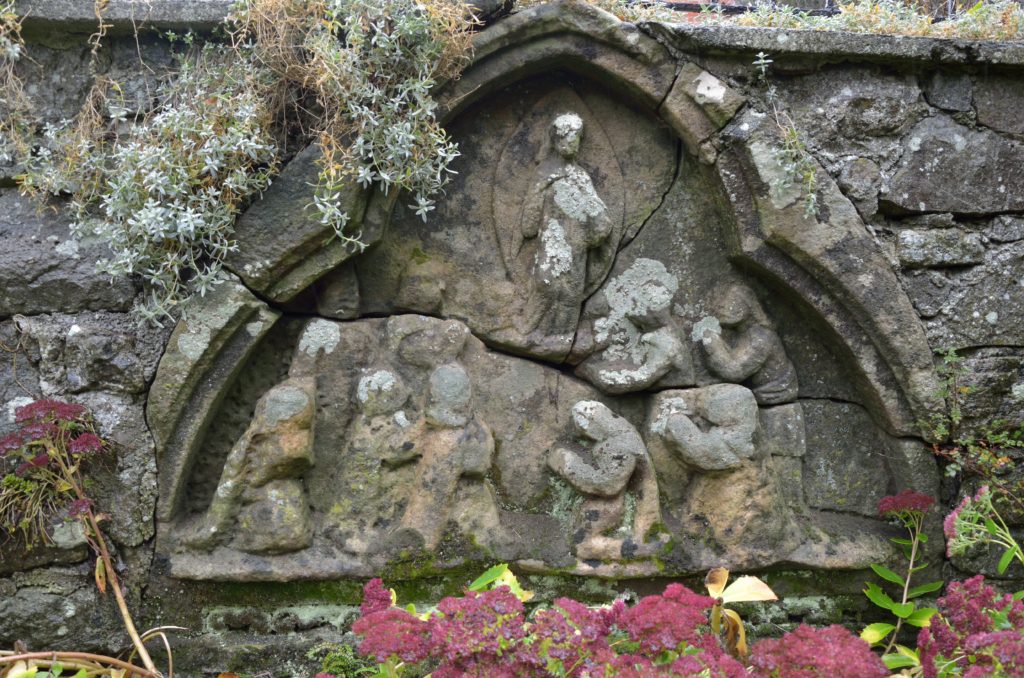MYSTERIES and MEMORIES
Why did the Cistercians choose Cwmhir ‘the long valley’ and how did they influence and use the local landscape?
Medieval monastic buildings have been well studied, but little has been done to interpret the wider landscapes within which these buildings sit. We know from medieval literature that the created world was regarded as a reflection of the human relationship with the divine. Our project will seek to identify appropriate data that will reveal how the builders of individual monasteries, including the orders themselves, their patrons, artists and their wider communities, designed these institutions into the landscape and how the landscape was adjusted to reflect the metaphysical. The sorts of features that we will be looking at include archaeological traces in the form of buildings, possible transport routes, agrarian systems and ancient hydrology and drainage.
We will seek to understand the way in which the monastery was laid out in relation to the topography and this will be set alongside the history, archaeology and geography of estate economy and political patronage.
Our approach will be steered by studies at Strata Florida in Ceredigion, in an upland and resistant Welsh culture where the Cistercian monastery of 1184 was designed into an existing sacred landscape dating back to the later Neolithic or early Bronze Age. This project has identified a consciously designed relationship between the monastery and the pre-existing landscape of sacred significance.
Our research also hopes to explore the extent to which the monastery was sustained as it encountered the major shifts of ideology, social, political and economic changes of the later Middle Ages and the early modern era.
The Mysteries of Abbey Cwmhir – a brief history

The founding of the Abbey of Cwmhir was part of the extraordinary expansion of the Cistercian Order inspired by St Bernard of Clairvaux in the 12th C. It was founded by the Welsh Lords of Maelienydd (Radnorshire) descended from the house of Elystan Glodrydd which ruled the area between the Severn and the Wye – Rhwng Gwye a Hafren. One of the many mysteries of Abbey Cwmhir is that one of the earliest Cistercian historians, (Ref 1), of the 16th C gives two dates for its founding, 1143 & 1176. Both are championed today although most specialists prefer 1176 when the powerful “King” or Rex d’Elfael, Cadwallon ap Madoc, (Ref 2), was ruler.
But the present ruins are from a building from after his murder in 1179 so another mystery is whether there was an earlier building as some archaeological evidence may suggest, (Ref 3). Yet another is, who commissioned it? Roger Mortimer gave a huge grant of land to the Abbey in 1200 but the Charter (found on lampshade parchment in 1956, Ref 4) does not mention a building. After his death in 1215 Llywelyn Fawr of Gwynedd controlled the area and it has been suggested that he built Cwnhir as a suitable Cathedral in the centre of Wales to have his son Daffyd crowned as Prince of Wales in 1238, (Ref 5).
It was certainly suitable for a Royal ceremony as the nave was judged to be “sumptuous”, (Ref 6), and was longer than Westminster Abbey or any other medieval Cistercian Abbey from Scandinavia to Syria. If it wasn’t Llywelyn Fawr who built it, then who, and why so ambitious? This is the central mystery of Abbey Cwmhir.
But not the end of its association with the Royal House of Gwynedd as Llywelyn’s grandson, Llywelyn ap Gruffud, the only Welsh Prince of Wales to be acknowledged by the King of England, and the last, may have been buried here. Certainly the Archbishop of Canterbury at the time thought so – Myth or reality? Another mystery to be resolved? Today his death is remembered by a Religious Service in the Remains on the Sunday closest to the day of his death December 11th 1282.
Henry III came to the door of the Abbey to burn it down but was distracted by a payment of 300 marks, the money set aside to build the East End. After the Black Death, Owen Glyndwr, self-proclaimed Prince of Wales, apparently “spoiled and defaced” the Abbey and in the Civil War, when the property was owned by a Cavalier, there was a skirmish which resulted in the Parliamentarians winning – the owner changed sides and continued in public office.
After Henry VIII demanded that all Abbey Churches in England and Wales be destroyed at the Dissolution in 1536, Cwmhir’s other buildings land came into the hands of private owners who improved the estate, built themselves large houses (often using stone from the Abbey’s buildings and the Church) and used the ruins as part of their gardens.
Since then many people have lived in the shelter of the Abbey remains, we know about the estate owners but the majority of people’s history is largely unrecorded. This is about to change.
Today it is a much loved peaceful location in the deep wooded sides of the long valley with a Cadw exhibition room supported by the Abbey Cwmhir Heritage Trust, one of the most interesting history societies in the area playing an active part in research work to do with the history of the Abbey, its archaeology and its place in the national heritage of Wales. We are planning a major 4-year community led heritage project to investigate the Abbey.
References
1. Angelo Manrique, (Spanish Abbot) Annales Cistercienses 4 Volumes to 1236 (Published 1642 – 466 years later), Vol 1, p. 452: gives the founding date as 11 kalends May 1243 [i.e: 21 April 1143]; and 6 kal. August 1176 [27 July 1176].
2. Paul Remfry, “Cadwallon ap Madoc Rex Delvain, (1140-7) and the re-establishment of local autonomy in Cynllibwg” TRS 1995 P 11.
3 Stephen Williams FSA “The Cistercian Abbey of Cwmhir, Radnorshire” Cymmrodorion Society Trabsactions 1894-5 pp 58-110
4 BG Charles “An Early Charter of the Abbey of Cwmhir” Transactions of the Radnorshire Society (TRS 1970)
5. Raleigh-Radford “The Cistercian Abbey of Cwmhir in Radnorshire” Archaeologica Cambrensis Vol CXXXI (1982)
6. John Leland “The Itinerary in Wales in or about 1536-92” Ed.Lucy T. Smith. (1906)
Our living history

For millennia history has been passed on via an oral tradition taking many forms including folklore, myths and real life stories. As such oral histories were the first kind of history. Word of mouth enabled memories, knowledge and experience to be shared through communities and generations.
The Abbeycwmhir Oral History Project continues that long tradition. We aim to gather, record and preserve a diverse range of personal experiences that will not have been captured elsewhere. The personal nature of these histories make them a special and fascinating source for those who wish to know more about life in Abbeycwmhir past and present.
We create history every day. We would like you to be part of that unique and inspiring experience. We are very excited by this project and, if you are too, please follow the link to our Oral History page.
